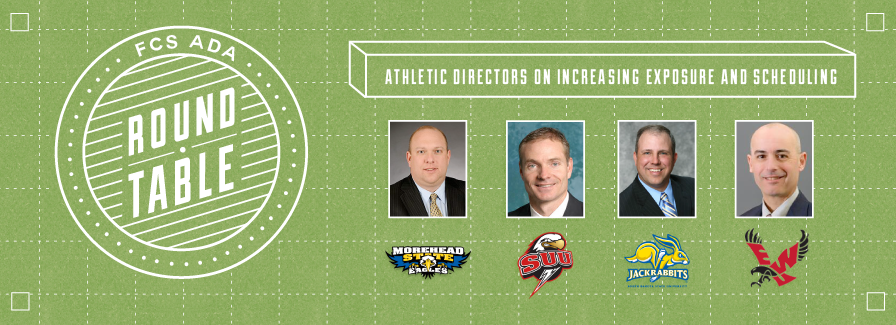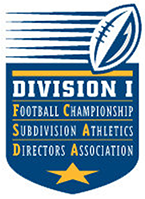
The compelling prospect of an annual tournament to crown a Division I football champion has kept fans and pundits busy speculating about the composition and implementation of the new format in the off-season. What some don’t realize is that a D-I football tournament has been in existence, and thriving, since 1978.
The Football Champion Subdivision’s playoff initially featured a four-team matchup and will boast a 24-team, single-elimination tournament in 2013.
The FCS ADA—Football Championship Subdivision Athletic Director’s Association—is the industry organization for ADs, its stated purpose to provide: a collective voice, a forum to discuss issues that impact the membership, offer a recognized relationship with other athletics director associations and NCAA leadership groups, and empower the membership in their roles as directors of athletics.
ADs at FCS schools are working industriously to spread awareness about the Division I football tournament with the rich history and exciting play. Ryan Matthews—Winthrop’s Managing Editor—sat down recently with four FCS ADA members, Brian Hutchinson (FCS ADA President) of Morehead State University; Ken Beazer (FCS ADA Second Vice President) of Southern Utah University; Justin Sell of South Dakota State University; and Bill Chaves of Eastern Washington University to discuss how the recent expansion of the postseason playoff impacts scheduling, and what the FCS is doing to solidify their brand nationally.
First, can you share your thoughts about the recent expansion of the postseason football tournament and its potential impact on scheduling?
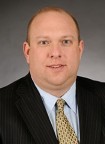 Brian Hutchinson – Morehead State University
Brian Hutchinson – Morehead State University 
Director of Athletics – FCS ADA President
Our subdivision has long had a championship field that didn’t properly represent the membership ratios that we are accustomed to seeing in other sports. It makes sense to have a championship field large enough to accommodate more deserving teams and/or leagues. Ultimately, it adds another weekend of exciting, well-played football that brings great attention to FCS schools.
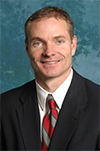 Ken Beazer – Southern Utah University
Ken Beazer – Southern Utah University 
Athletic Director – FCS ADA Second Vice President
I believe this is one of the most significant achievements we have made with regards to advancing and promoting FCS football. Expanding postseason opportunities creates excitement across more campuses and communities. Furthermore, the expanded playoffs structure provides AD’s more flexibility in creating future schedules.
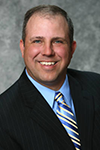 Justin Sell – South Dakota State University
Justin Sell – South Dakota State University 
Director of Athletics
FCS football has arguably been the toughest sport to make the post-season; expanding the championships allows us to recognize tournament-worthy teams and provides the highest quality experience for the student-athletes. If a team doesn’t win the conference regular season title and gain an automatic bid to the playoffs, scheduling is always a critical element in positioning a program for an at-large playoff bid.
Scheduling will remain important with the expansion of the post-season and it will be interesting to see how the RPI of BCS/FBS, FCS non-scholarship and Division II games will impact the ability to complete a schedule and make the playoffs. Given our location, it will be important to have as many options open to ensure that we can balance our home/away games.
 Bill Chaves – Eastern Washington University
Bill Chaves – Eastern Washington University 
Director of Athletics
The recent expansion, along with the use of technology in determining strength of schedule for each potential at-large team, will be a tremendous advancement for the playoffs this year. Given our geographic location, scheduling is always interesting for us. Since 13 of the 14 FCS schools west of the Rockies play in our conference, the ability to put together a non-conference schedule is different each and every year.
The FCS recently launched a new logo and branding campaign—what is another aspect of FCS Athletics you wish had wider visibility amongst fans, recruits, and the media and what is your program doing to bring more attention to your subdivision?
 Brian Hutchinson – Morehead State University
Brian Hutchinson – Morehead State University 
Director of Athletics – FCS ADA President
We have embraced the new branding initiatives in utilizing the marks everywhere we can…player guides, game programs, uniforms, and the like. We have engaged our local media about the weekly polls and are sharing that in our newspaper. Geographically, we are equidistant from two FBS programs, so we need to do our part to continue educating fans and media about FCS football, not only our program, but the national picture as well. It’s Division I football and played at a very high level. I believe it’s important to continue beating that drum.
 Ken Beazer – Southern Utah University
Ken Beazer – Southern Utah University 
Athletic Director – FCS ADA Second Vice President
I applaud the increased efforts and commitment of the NCAA to get the FCS brand out in front of the public. I believe the hallmark of what we do at this level is centered around the playoffs; therefore, institutionally, we need to promote and champion the playoffs relentlessly within our own communities. If we don’t do it, who will?
 Justin Sell – South Dakota State University
Justin Sell – South Dakota State University 
Director of Athletics
I think FCS has done a great job in marketing and branding our level of football. It would be nice to see the national media take more of an interest in the quality of our product and institutions. A weekly Saturday spotlight on FCS vs. a one-time ESPN Game Day show would be an interesting concept. We are able to compete with the larger programs, we send student-athletes to the NFL and we play an exciting brand of football.
SDSU football is proud to tout a grade point average over 3.0 for the past 5 years while having student-athletes garner national attention for on-field achievements. We started our own television show a few years ago to highlight these accomplishments, are done fundraising for a new practice facility ($30.8 million), and will build a $60 million football stadium to open in the fall of 2016. These projects impact our state and allow us to tell our story to a broader audience.
 Bill Chaves – Eastern Washington University
Bill Chaves – Eastern Washington University 
Director of Athletics
I was tremendously impressed with ESPN sending GameDay to Fargo and putting a spotlight on the FCS. I always thought that a similar FCS GameDay Show on ESPNU would make sense, but I realize there is a cost associated there. This level of football is so appealing that once the audience has been exposed, the result may be that it really jumpstarts the FCS brand.
What traits and intangibles do you look for in a coach, and how do you go about trying to retain a successful coach, knowing that FCS coaches sometimes move on to larger programs after attaining success?
 Brian Hutchinson – Morehead State University
Brian Hutchinson – Morehead State University 
Director of Athletics – FCS ADA President
Every situation is unique, but generally, it’s about fit with our institution and our program. Where are our weaknesses that caused us to have a vacancy (in the case of hiring a new coach) and how does making a change fill that void? Incentives and security are both places that we can have a little more flexibility in dealing with retaining a successful coach. Also, making sure we do all we can and being attentive to the needs of the program can go a long way in substituting for immediate financial considerations.
 Ken Beazer – Southern Utah University
Ken Beazer – Southern Utah University 
Athletic Director – FCS ADA Second Vice President
I look for coaches who have a realistic plan for success and the passion to see it through. Additionally, they must be a good fit for me, the university, and the community.
My role in retaining quality coaches is to keep them from making a lateral move. In order to do this, I must be constantly working to ensure my coach sees his efforts are matched by my efforts for program enhancement.
 Justin Sell – South Dakota State University
Justin Sell – South Dakota State University 
Director of Athletics
In my opinion, every coach must have a professional knowledge of the game AND be able to communicate/teach to the student-athletes. These are non-negotiable (same with Academics, Compliance and Budget). Other qualities and intangibles I look for are being part of a successful program, proven record of recruiting quality student-athletes, team contributor to the department and university, high personal and professional integrity, and hiring coaches who want to be at South Dakota State University.
In dealing with retention, we constantly work hard at paying market value, continuous improvement, planning and providing budgets/facilities that allow us to compete at a high level. The difference maker to me is that we treat this as our family and truly value and expect our employees to be sensitive to maintaining a positive work-life balance.
 Bill Chaves – Eastern Washington University
Bill Chaves – Eastern Washington University 
Director of Athletics
I think a coach with a complete understanding of their institution is a tremendously underrated trait, especially at the FCS level. Each school has its own strengths, weaknesses, and nuances—by embracing all of it you have a great chance to be successful. I am of the firm belief that if you are doing things right and having success, then more opportunities may arise. You need to take a hard look at what the future holds and make sure all parties will have success, your department included.
How do you set and manage the expectations of fans, boosters, and alumni who are perhaps accustomed to the spending habits of larger programs?
 Brian Hutchinson – Morehead State University
Brian Hutchinson – Morehead State University 
Director of Athletics – FCS ADA President
Education and reminding folks that every school is different. TV contracts have a lot to do with how programs can operate and since these are so widely reported on now, we don’t have the same issues we used to have with regard to education of our fans. We have the same fans as many larger programs, so their experiences need to be similar when they visit our website or our campuses…at least to the extent we can manage. We absolutely can manage information by doing great work with audio, video, and websites and we can make sure they are comfortable when they come to campus.
 Ken Beazer – Southern Utah University
Ken Beazer – Southern Utah University 
Athletic Director – FCS ADA Second Vice President
This has not been an issue so far. The majority of our fans and boosters understand the current pecking order of the various college budgets and have willingly embraced the underdog mentality.
 Justin Sell – South Dakota State University
Justin Sell – South Dakota State University 
Director of Athletics
We do a lot of homework, research and data analysis to help set parameters and expectations within our own program (Win AD makes this easy!). This allows us the opportunity to communicate with our fan base on where we are today and where we need to go to remain competitive. Our fans are generally very good at understanding the difference between BCS/FBS vs. FCS, and maintaining reasonable expectations.
 Bill Chaves – Eastern Washington University
Bill Chaves – Eastern Washington University 
Director of Athletics
I think each school is different in regard to spending. We are always trying to better our situation, but there are truly things that money cannot buy. We offer something exciting and valuable that can’t necessarily be quantified. I hope that we can continue to have success to the point where there are even greater expectations. With that, there is a fine line between winning and losing—you need to be thankful for every successful season because nothing is every guaranteed.
What advice would you give to a talented young administrator that you wish someone had given you early in your career?
 Brian Hutchinson – Morehead State University
Brian Hutchinson – Morehead State University 
Director of Athletics – FCS ADA President
Manage your schedule. Don’t let things that aren’t urgent become the drivers of your day.
 Ken Beazer – Southern Utah University
Ken Beazer – Southern Utah University 
Athletic Director – FCS ADA Second Vice President
Dreams are great, but they are only dreams until you have a logical plan and take your first step.
 Justin Sell – South Dakota State University
Justin Sell – South Dakota State University 
Director of Athletics
To network with the thought in mind that the people you work with or get to know might be an important hire for you in the future. Having talented people is absolutely critical to achieving academically, athletically, and financially. In addition, I believe it is important to master the job you have been hired to do and then go out and learn as many other aspects of our business as time and opportunity allow. I have never worked for a department that did not allow a person to push the envelope and contribute in a variety of ways, and the beauty is all it usually takes is hard work!
 Bill Chaves – Eastern Washington University
Bill Chaves – Eastern Washington University 
Director of Athletics
Leadership can happen from any chair in the department and understanding/learning all aspects of the department, especially the areas that you are not involved in, is key. In addition, no one is entitled to anything and there is absolutely no substitute for hard work. Finally, be the best at what your current role is right now—if you cannot do that, chances of attaining more responsibility will be highly unlikely.

